Surgical reshaping of the chin helps to create a harmonious image and has a pronounced rejuvenating effect due to a neck lift and correction of facial contours. This effect makes mentoplasty a rather popular plastic surgery, however, it requires careful selection of the shape of the implant and the method of its installation, otherwise the operation is fraught with serious complications.

Andrey Stanislavovich Guryanov
Member of the Society of Plastic, Reconstructive
and Aesthetic Surgeons of Russia,
PhD,
Certified Plastic Surgeon
with 30 years of practice.
Surgical methods for mentoplasty augmentation
Surgical chin augmentation can be performed in two ways – using sliding mentoplasty (horizontal osteotomy) and using implants. Each of these methods has its advantages and disadvantages.
So, performing a horizontal osteotomy requires good skills from a plastic surgeon. The essence of sliding mentoplasty is to increase the projection of the chin with the help of bone tissue, pushing it slightly forward. In principle, we are borrowing bone tissue in one place and shifting it to another.
Horizontal osteotomy gives a good aesthetic result. Its disadvantages are that, in principle, the chin can be pushed forward only up to 5 mm forward, then a rather pronounced bone "step" appears, i.e. we are facing bone deficiency.
Metoplasty performed with implants is technically simple, has a predictable result, and is reassuring in its reversibility. Most often, it is carried out using standard chin implants, which are presented in a wide range. They are very attractive, practical, but often require adjustment and need to be well fixed in fabrics, as problems can arise due to their displacement.
Reasons for repeated visits of patients after mentoplasty
The reversibility of implant-assisted chin reshaping allows patients who are dissatisfied with the results of the operation to seek revision mentoplasty.
As a rule, patients come in with the desire to replace the chin implant, expressing the following complaints:
- Dissatisfaction with facial proportions.
- Irregularities in the contour of the chin.
- Chin shape asymmetry.
- Implant mobility.
- Sensitivity disorder.
- Violation of facial expressions and diction (which we did not pay attention to before).
We tried to analyze the features of mentoplasty and identify the main reasons for the unsuccessful results – why patients remain dissatisfied with the shape of the chin, despite the correction, for what reason the implant can be displaced. In addition, we tried to trace the interaction of the implant with surrounding tissues, the position of the implant in relation to the bone, access options for implant placement and their impact on effective postoperative healing, and also drew attention to the possible causes of neurological and functional disorders associated with chin correction. .
Prerequisites for frequent dissatisfaction with mentoplasty results
The global cause of dissatisfaction with the shape of the chin in patients is the diversity of their aesthetic needs. Everyone wants to look original.
The second premise is the wide variety of chin anatomy. In addition to the variety of forms, there is always asymmetry of varying degrees, bone tubercles, spikes, etc.
This leads to the fact that, in principle, it is very difficult to satisfy the requests that patients put forward with standard implants. Although today the range of implants that many companies provide us is very wide.
When patients return, the following problems are revealed:
- errors in the analysis of appearance that were made by the surgeon;
- errors in choosing the shape of the implant;
- insufficient assortment of implants, when they simply could not be found for solutions to a specific problem;
- errors made by the surgeon when installing the implant.
Why mistakes happen during mentoplasty
What is the surgeon looking for when choosing a chin implant? This is a profile analysis and face analysis in front. Two angles are used at best, and most often one. However, a person is a three-dimensional object. And everyone wants to see themselves beautiful from all angles.
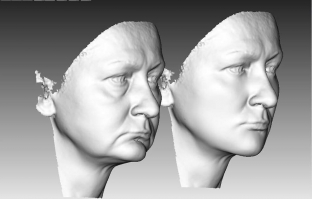
Patient after unsuccessful mentoplasty and after prosthetics with a customized implant.
4 causes of complications:
- 1 - excess forward projection calculated;
- 2 - insufficient downward projection;
- 3 - incorrectly selected implant;
- 4- the required standard implant simply does not exist.
Causes of implant displacement
We have analyzed the reasons why the placed chin implants can move. There are two of them: initially inaccurate placement of the implant and its unstable position.
Why can an inaccurate placement occur? When installing through the external incision, there are no exact landmarks on the bone, so any inaccuracy leads to asymmetry.
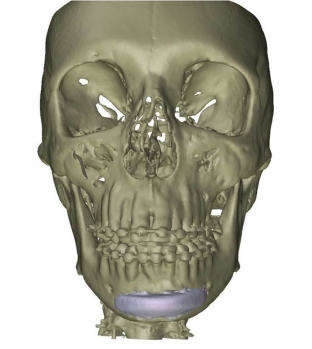
Implant placed asymmetrically
Another reason for implant displacement is when the implant seeks an equilibrium state on the jaw, when it can no longer move further. This results in typical misalignments like the photo below.
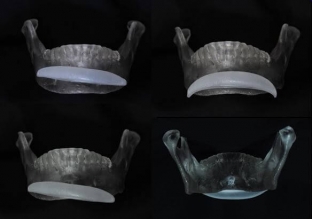
This can be compared to moving a ball into a stable position, as in the picture below.
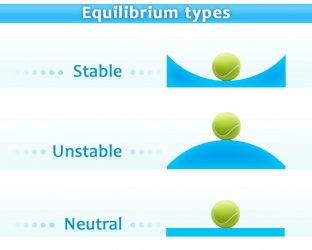
There are several ways to deal with implant misalignment. The simplest of them – fix the implant to the bone. An increase in the accuracy of its installation will also add stability to the chin implant: it is convenient to do it through the mouth - then you see the inter-incisal line and can say for sure that this is the middle of the jaw. In order to place the implant in a stable or neutral state, you must find some comfortable low position for it, or make the implant congruent to the bone surface by turning and fitting it.
Types of implant interactions
Stability and reliability, the safety of the chin implant installation depends on the interactions that occur between the inserted implant and its surrounding tissues. We analyzed the significance of the chemical nature of the implant, its interaction with soft tissues and bone, the significance of the physical properties of the implant (surface, material density, area) and came to the following conclusions.
We can't say for sure, because this requires serious thorough research, but we believe that the material of the implant, its chemical nature, in principle, does not matter – provided that this material is biologically inert. Such materials are silicone, Teflon and polyethylene, which have long been used in plastic surgery.
It's all about the density of the material and its surface. We empirically determined the required density of the implant, its surface roughness and configuration, which prevent negative reactions from the surrounding tissues. All this prevents the formation of a dense fibrous capsule around the implant and atrophy of the bone adjacent to it.
Implant position in relation to bone
There is an opinion that implants can be placed in soft tissues. The option of installing an implant in soft tissues, or at least partially in soft tissues, is fraught with the fact that a fibrous capsule will grow on its back surface. And this fibrous capsule will eventually push the implant away from the jaw. At best, we will get micro-movement, and at worst – ptosis of this implant. In addition, with micromotion, the oscillating ends of the implant cause fibrosis of the surrounding tissues. The free position of the implant is also dangerous because it can be extruded. Thus, the implant can only be placed under the periosteum.
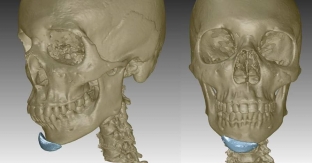
The implant is placed in soft tissue. This led to the displacement of the implant down and sideways
Neurological and functional disorders
At first we did not pay attention to functional disorders, but it soon became clear that they are quite common. And they began to look for the causes of the development of these disorders. We often observe a violation of the sensitivity of m.mentalis, which occurs due to compression by its implant, scars, sometimes there is even direct damage, although this is quite rare.
With excessive cicatricial deformity and pressure from the implant, a “witch” chin.
Most often of the functional disorders, we observe dysfunction of the muscles that lower the lower lip. At the same time, patients perform the test poorly – collect lips in a tube. This is most often due to incorrect implant position and scarring.
Own approach to mentoplasty
Based on the collected and analyzed data on the reasons for unsuccessful results of chin correction, on the materials and shapes of implants, on their interaction with tissues and bone, on postoperative complications, we have chosen our approach.
One of the factors that ensure a successful outcome of mentoplasty is individual implants, which should be made of soft silicone and have a textured surface.
When working with a patient, CT scan data are necessarily used in order to assess the shape of the chin, to check which implant was previously, what the projection and posterior surface of the new implant should be, so that it is maximally adapted to the bone.
It is important for us to individually calculate the parameters of the implant for each patient, while the installation is carried out only under the periosteum, and this avoids the need to fix the implant to the bone.
Implant placement method – intraoral. We make an incision through the vestibule, but the incision was moved not into the fornix, but closer to the lip. We don't cross the m.mentalis, but separate it. In the future, we perform a subperiosteal detachment and the implant is installed through this hole, which is quite sufficient even for a very large implant, reaching the sixth teeth. In this way, the incision is carried slightly higher and the possibility of saliva contamination and rough scarring is eliminated.
Observations
In our practice during 4 years of mentoplasty, we did not have a single suppuration or rejection of the implant when it was installed through the oral mucosa. Access for implant placement through the oral mucosa is safe.
We believe it is better to use implants made of softer silicone with a developed textured surface, because they do not allow the formation of a hard capsule that presses the implant into the bone.
Subperiosteal placement is mandatory. Failure to do so increases fibrosis around the implant and increases implant displacement.
Around implants made of denser silicone, as a rule, a denser fibrous capsule developed, and under it, more pronounced atrophy of the bone tissue. With a more developed surface of the implant, the capsule around it is less pronounced.
Standard implant designs are in most cases unsuitable for recreating natural contours and such implants do not adapt well. Therefore, on-site modeling and mandatory fixation to the bone is required.
Source estet-portal.com







Add a comment